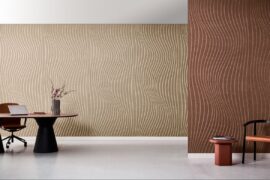Angela Ferguson visits a modern hotel in traditional Kyoto.

February 17th, 2015
Kyoto has a reputation for being one of the more traditional cities of Japan; many tourists come here to see shrines, temples and facets of ‘old Japan’. So Hotel Kanra is somewhat of an anomaly in Kyoto – it is delightfully modern, and sits comfortably amongst the most beautiful boutique hotels in the world.
Completed in 2010, Hotel Kanra was designed by architect Norito Nakahara. The overall design is based on the proportions of Kyoto’s machiya (wooden town houses). This is evident in the elongated shape of the rooms and the palette of materials used including volcanic stone flooring, tatami mats in sitting areas, traditional Japanese hiba (cypress) wood bathtubs, frosted glass bathroom walls and shoji screens.
Like many things in Japan the attention to detail is exquisite. And it is the small details that make this hotel extra special. These include custom made lamps of tiny white threads (referencing cushion stuffing) and skylights in the bathrooms that give the impression of being connected to the outdoors.
The entry lobby is essentially an installation piece and was created by Tokyo based New Yorker Alexander Reeder. Large triangular interactive panels on the walls and ceiling change colour depending on the season as well as the light, sound and temperature in the lobby and restaurant.
In many areas of the hotel the work of local artists is featured via ceramics, ikebana (flower arrangement), lighting design and hanging wall art.
Hotel Kanra was conceived to support the local community and to educate visitors about historical Kyoto in a thoroughly modern manner. This has been done in a way that is respectful to the heritage of the area whilst at the same time presenting the Japanese conscience in a contemporary setting.
Hotel Kanra is an embodiment of Japanese aesthetic values; these values have developed over many centuries and are about creating a state of mind that is peaceful and harmonious. We truly felt this during our visit here – once we’d arrived we felt very much at home and it became extremely difficult to leave such a beautiful sanctuary.
Hotel Kanra
hotelkanra.jp
To follow Angela and Stephen’s journey through Japan go to instagram @futurespacedesign @indesignlive and look out for the hashtags #futurespacetravels #indesigntravels
INDESIGN is on instagram
Follow @indesignlive
A searchable and comprehensive guide for specifying leading products and their suppliers
Keep up to date with the latest and greatest from our industry BFF's!
The new range features slabs with warm, earthy palettes that lend a sense of organic luxury to every space.

London-based design duo Raw Edges have joined forces with Established & Sons and Tongue & Groove to introduce Wall to Wall – a hand-stained, “living collection” that transforms parquet flooring into a canvas of colour, pattern, and possibility.

For Aidan Mawhinney, the secret ingredient to Living Edge’s success “comes down to people, product and place.” As the brand celebrates a significant 25-year milestone, it’s that commitment to authentic, sustainable design – and the people behind it all – that continues to anchor its legacy.
The internet never sleeps! Here's the stuff you might have missed

In contemporary interiors, ensuring a sense of comfort and wellbeing means designing and specifying finishes and products that support all the senses.

Celebrating ten years of creative impact, Melbourne Design Week 2026 invites designers, studios, and collectives to submit expressions of interest for its statewide program and the Melbourne Art Book Fair.